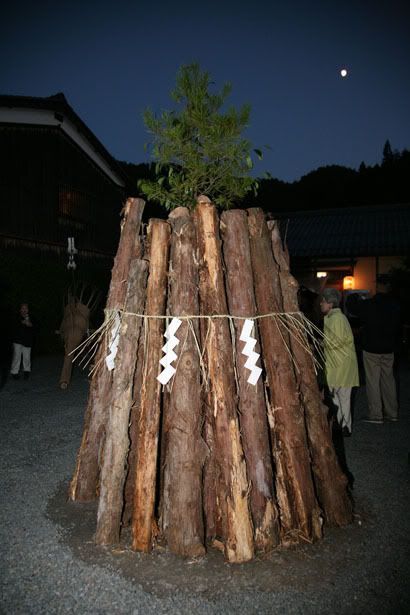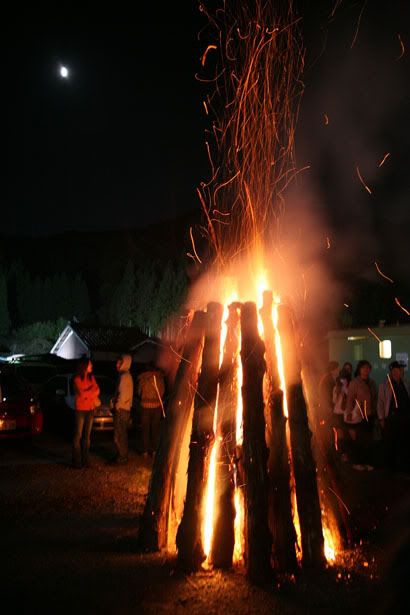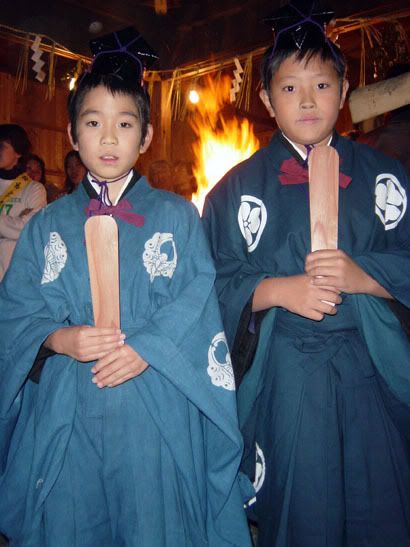Japan's wealthy playboys and camera-toting tourists are not the only ones drawn to the soft, red glow of Gion's paper lanters. Kyoto's most famous hanamachi, or geisha entertainment district, is also the preferred hangout of murders of young crows!
(Narrator): "Gion is crowded with people, but they're all worried about what's overhead..."
(Geisha Customer): "I was just saying, right? (maiko: Yes, you were.) You have to be careful with good kimono.
Geisha: That's right.
(Maiko in green, Yukako): "It's nasty, isin't it! Lately its always falling right before my eyes. I can't stand it!
(Narrator): Just then...
It's raining poop! An innocent bystander is splatter with white bird droppings!
(Maiko): Oh no! You went out (from under the covered walkway).
(Geisha): I was suprised! Onii-san (big brother),the timing! Poor thing!
(Poor thing): It doesn't come out!
(Geiko): But it's dangerous over there, too. There are so many (birds) up there.
(Narrator): And again... (Another poop bomb splatters the pavement).
Blah, blah, blah... I just thought that first bit was hilarious! Especially since I have seen people fall victim to the occasional poop bomb, although I myslef have yet to be targeted. (^_^)x <--- That's me keeping my fingers crossed.
Thursday, January 31, 2008
Pooping on Gion : Geisha Beware!
Sunday, January 27, 2008
Snow Smile : スノースマイル: English Translation : Bump of Chicken
Another one of my favorites!
Snow Smile by Bump of Chicken
It’s a really good thing winter is cold
Because there's no better reason
To invite your chilly left hand
Into my right pocket
“I wish it would snow!” you say with a pout
Well, if it doesn’t go the way you like
Don’t kick away the fallen leaves
We can still fall down in them
Why do you look like you’re having so much fun
Even though you’re angry?
In the still beautiful, untouched carpet of snow
Together we carve parallel lines of footprints
Even if this dream story never comes true
Smiles will overflow
This snowless road
There’s a little trick to our walking together
Your stride is so small
I look at the scenery as long as I can
Looking back at the scenery of you
Into the still dry curtain of the sky
Together we chime an orchestra of footsteps
Look! Before this dream story comes true
You will smile for me
I know it
Snow Smile
In the still beautiful, untouched carpet of snow
Together we carve parallel lines of footprints
Yes, even if you don't wish for this dream story
You taught me to smile
On the path that I take
I’m so happy we met
The same season has come around again
In my right pocket, the memory I put away
Just as I thought, I put it away and walk
On a path without you
Tuesday, January 22, 2008
Made of Japan : I ♥ Onitsuka Tigers!

How cool is this ad art for Onitsuka, inspired by Japanese wood block prints with Japanese proverbs. On the left: "Deception is like a monkey. It's only a matter of time before it bites you". On the right: "Debating with a fool is like spitting on a fish. It's best not to bother." Can I get an Amen?

Lately a lot of visitors to my little blog here have been coming over from the awesome concept ad site, Made of Japan. A classic mosaic Onitskua (AKA Asics in the US,) made up of thousands of images from over 150 Nippon-centric© blogs. True to the Onitsuka motto, the shoes are literally Made of Japan! As you roll over the mosaic, tiny windows pop up showing the image and proving a link back to it's source.

One of my images of Kikutsuru, then maiko of the Miyagawa district.

Another image of a few of my students.
Ever since my super-rad, high school cheerleading days I've been a uber-fan of Asics, which weren't exactly considered cool at the time. Must of been the Japanese sensitivites laying dormant within me, silently drawing me towards my destiny as a full-fledge Japanophile. Imagine my excitement when I came to Japan and realized they were actually Japanese- with a lot more style and a way cooler name to boot!
I also love that they've taken "Made of Japan", something I always assumed to be a Japanglish phrase, and made it meaningful. Rockstars, all of them!
Onitsuka Tigers are MADE OF JAPAN!
Otagaki Rengetsu : Lotus Moon
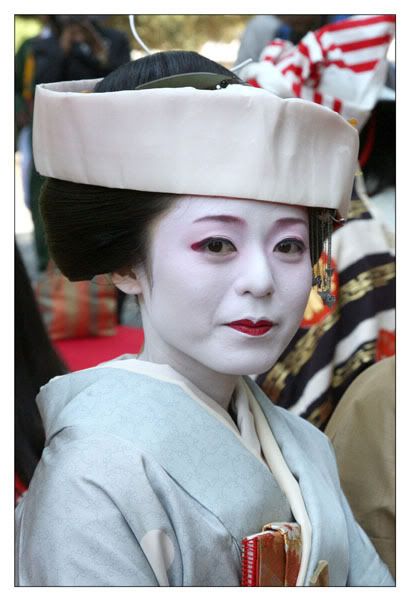
Otagaki Rengetsu, best known as a famous Japanese poet, was also a calligrapher, potter, and painter.Born into a samurai family with the surname Todo in 1791 , she was soon adopted by the Otagaki family and given the name Nobu. Having lost her mother and brother at a young age, she served as lady-in-waiting at Kameoka Castle (in present-day Kyoto Prefecture) from the age of 7 until returning home at the age 9 years later to marry. In 1823, after the death of her husband and three young children, she became a Buddhist nun, adopting the name Rengetsu, which means "Lotus Moon".
Life in the Mountains
Living deep in the mountains
I've grown fond of the
Solitary sound of the singing pines;
On days the wind does not blow
How lonely it is!
Longing in the Wind
I await my beloved
who is not yet here.
The moon in the pines
and voice of the wind
provoke my longing
Monday, January 21, 2008
Bye Bye Britboy.
As I'm sure you have noticed I haven't been posting in a while. To be honest I'm not sure what I'm going to do about this little blog of mine. It has been a big part of my life for a few years now...
Therefore I'm going to be taking a break until I decide what is best to do. I'm working on some other very exciting projects at the moment and I sincerely hope that any readers I still have will take a look at them when they surface. The way I'm feeling right now I'm not going to continue with the celebrity blog but Britboy in L.A. might morph into something entirely different...
I'm sorry to those of you who have emailed me asking when I will update again, and I don't want to keep your hopes up. I don't want to say this is the end because it isn't... this is just goodbye for a while and there is something even more exciting round the corner!
Thank you to everyone who has ever read, commented on, emailed me about, written about, talked about or told a friend about my blog, it means a hell of a lot to me. I hope to entertain you all again very soon with something different!
Alexx
p.s. If you are severely emotionally scarred by the departure of Britboy then visit http://www.youtube.com/alexxshannon and check out some skits I recently filmed with some friends.
p.p.s: This post is actually my 400th! Do i have good timing or what?
Thursday, January 17, 2008
Kurama Fire Festival : 鞍馬の火祭り
Nestled high in northern Kyoto's mountains, the rural town of Kurama consists of traditional, tiled-roof homes and shops crowded along a single main road, narrowly winding its way through the evergreen mountaintops that rise on either side. Each year, on October 22, as the moon begins to rise over these steely blue ridges and night casts its sleepy shadow over the usually quite town, a river of visitors from all over Japan flows from the small, provincial train station, flooding the town in a buzz of anticipation and excitement as they prepare to witness the rites and rituals of Kurama's famous Fire Festival. The Kyoto Shimbun Newspaper numbered the festival-goers in 2008 at over 10,200!


Today the sacred Shinto rituals begin at 6 pm, but visitors begin arriving long before, seeking out the best places to experience the event and vying to get as close to the action as possible. By the time the sun disappears behind the hills, all open areas along the main road are filled with space-impaired spectators, corralled behind ropes and barriers to keep them a safe distance from the madness that will eventually ensue. Late-comers are ushered behind the early bird crowds by a seemingly infinite number of policemen, politely prodded to keep moving on a continual circuit from the train station, through the town, and back again, past homes and shops with torches of all sizes displayed proudly outside.



A high school students shoulders the tail end of a 5 meter torch as sparks rain down behind him. Catching one of these falling sparks on your skin is said to be very auspicious, if not painful.
 These enormous torches weigh over 100 kilos, or 220 pounds.
These enormous torches weigh over 100 kilos, or 220 pounds.
 A group of scantily clad young men show off their "cute hips" in the revealing traditional festival gear.
A group of scantily clad young men show off their "cute hips" in the revealing traditional festival gear.


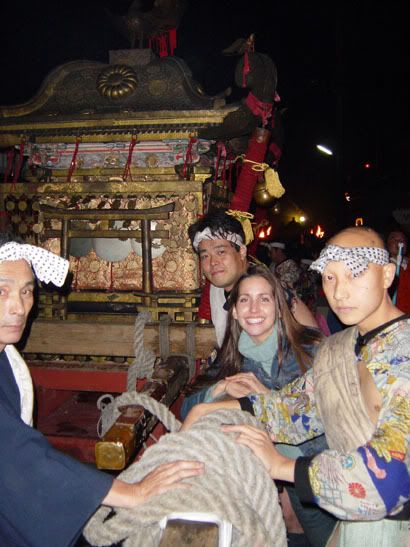
The omikoshi and I with my new friends.
 Any Japanese festival is a great place to make new friends!
Any Japanese festival is a great place to make new friends!
Monday, January 14, 2008
Chopsticks are so Tricky...
A funny little commercial by the independent productions company Fatal Farm.
The ending holds a special meaning for me, as it brings to mind meeting of the Thursday night sushi crew in which I, while raising a peice of nigiri salmon to my mouth, watched in amazement as it slipped from my chopsticks, flipped head over tales and flew through the air, diving gracefully into CP's cup of green tea half way across the table.
Wallah! Ochazuke!
The entire incident unfolded before my eyes in slow-motion, inducing a laugh attack the likes of which the Ena kaiten sushi scene had never seen.
'But seriously,' you may ask, 'how does that happen'? Only I in my infinite wisdom could achieve such a feat without effort of any kind. (You are welcomed to try, of course, if you think you can do bettter).
In my own defense, I actually do use chopsticks rather well (better that most of my students) and prefer them to silverware. And, like most foreginers in Japan, I have been complimented countless times on my fine form by everyone from kindergarteners, to teachers, to a maiko and the mistress of a teahouse!
Monday, January 7, 2008
I'm a National Geographic Traveler!

My image of a wagasa, or traditional Japanese paper umbrella, was chosen by National Geographic Traveler's blog, Intelligent Travel, for their Global Eye feature after an editor happened to see it on Flickr. Needless to say, I'm honored!
Check out the website for more excellent images and insight into authentic and sustainable travel.
Saturday, January 5, 2008
Where Did 2007 Take You?
 From top to bottom, left to right: Matsumoto Castle (Nagano), geiko in Kamishichiken (Kyoto), the Imperial Palace (Kyoto), Kiyomizudera (Kyoto), Oi Kindergarten (Ena), Kurama fire festival (Kyoto), maiko in Gion (Kyoto), Angkor Wat (Cambodia), maiko (Kyoto).
From top to bottom, left to right: Matsumoto Castle (Nagano), geiko in Kamishichiken (Kyoto), the Imperial Palace (Kyoto), Kiyomizudera (Kyoto), Oi Kindergarten (Ena), Kurama fire festival (Kyoto), maiko in Gion (Kyoto), Angkor Wat (Cambodia), maiko (Kyoto).1. Angkor Wat, Cambodia :
3. Battambang, Cambodia:
Went on a tuk-tuk tour with my old friends, the monks, wandered the rice fields, took a ride on the bamboo express and spent some quality time with my Cambodian family.
4. Taipei, Taiwan:
Spent a wonderful night curled up on an airport coffee shop couch shaking after drinking my first cup of real coffee EVER. What does Taiwain have against Chai tea?!
5. Nagoya, Aichi, Japan:
An oasis of Chai in a veritable dessert of delicious, non-coffee drinks!
6. Ena, Gifu, Japan:
Emraced by rolling mountains and chock full of rice fields, the lovely little city I was blessed to call home: Winter, Spring, Summer, and Autumn
7. Matsumoto, Nagano, Japan:
Castle-bound, a lovely little roadtrip gone right!
8. Nagano, Japan:
Lovely little roadtrip gone wrong- but what a great adventure!
9. Kyoto, Japan:
Geisha, festivals, temples, palaces. My happy place- a home away from home... away from home.
10. Tokyo, Japan:
Adentures with the Howell Kyodai.
11. Osaka, Japan
Reuniting with my Gaidai friends is always fun!
12. Nara,Japan:
A suprise trip to the ancient captial, ablaze with the colors of fall, to view the Shoso-In Exhibition of National Treasures. Icredible!
13. Inuyama, Aichi, Japan:
Japan's oldest castle: another great desitination for a roadtrip.
14. Cleveland, Ohio, USA
15. Omaha, Nebraska, USA
16. Duluth, Minnesota, USA
Where did the year take you?
Share your list in the comments section!
Friday, January 4, 2008
New Year, New Kind of Geisha?
 Visit Sayuki's Website
Visit Sayuki's WebsiteAs I'm sure most geisha enthusiasts already know, Aussie social anthropolgist Fiona Graham made her formal debut as a geisha in Tokyo's Asakusa district on December 19th after a year of training, or "feild work", as she refers to it on her website. Just in time to begin the new year as Japan's first western, professional geisha, she is already planning to release a book entitled "Sayuki: Inside the Flower and Willow World" and a documentary that will be filmed throughout the year.
The maiko of Kyoto endure intensive training for 5-6 years before earning the honor of turning their collars and becoming full-fledged geiko.
Graham's professional name, Sayuki, comes from the Chinese character 紗 sa, meaning gossamer and 幸 yuki, meaning happiness, wish or fortune. This could be translated a number of ways: Delicate Delight, Ethereal Joy, or Sheer Bliss (^_^)v
Graham recieved her MBA in Psychology and teaching from Oxford before beginging her study of social anthropology. She has spent half of her life in Japan, graduating from a Japanese high school long before becoming the first western woman to graduate from Tokyo's Keio University.
Read the Telegraph's article: Westerner inducted into mysteries of geisha















